|
|
|
Sort Order |
|
|
|
Items / Page
|
|
|
|
|
|
|
| Srl | Item |
| 1 |
ID:
148928
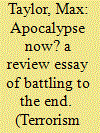

|
|
|
| 2 |
ID:
148922
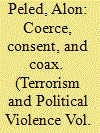

|
|
|
|
|
| Summary/Abstract |
Government Accountability Office reports and secondary sources reveal that the U.S. Congress has employed three distinct legislative approaches to address the federal counterterrorism information-sharing impasse: coerce, consent, and coax. One main example illustrates each approach: the Homeland Security Information Network project exemplifies the coerce approach; Intellipedia illustrates the consent approach; the office of the Program Manager of the Information Sharing Environment exemplifies the coax approach. Secondary examples are utilized including those of regional Fusion Centers, the Office of the Director of National Intelligence, and the National Counterterrorism Center. The merits and challenges of the three approaches are discussed and compared. The conclusion proposes ideas for using the approach most appropriate to specific counterterrorism challenges.
|
|
|
|
|
|
|
|
|
|
|
|
|
|
|
|
| 3 |
ID:
148925
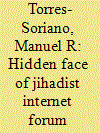

|
|
|
|
|
| Summary/Abstract |
This article offers a descriptive analysis of the private interactions which took place on the jihadist Internet forum known as Ansar Al Mujahideen between 2008 and 2010. The analysis of the non-visible part of the forum contributes to a more robust underpinning of some current assumptions regarding the jihadist Internet infrastructure and its hierarchical dependence on, and subordination to, formal terrorist organisations and charismatic leaders. In addition, it offers a new perspective on other aspects such as the many conflicts and rivalries between the different forums, the operational constraints caused by the lack of human and material resources, and the considerable vulnerability of the forums to cyber-sabotage and infiltration attempts.
|
|
|
|
|
|
|
|
|
|
|
|
|
|
|
|
| 4 |
ID:
148930
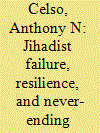

|
|
|
| 5 |
ID:
148929
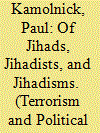

|
|
|
| 6 |
ID:
148924
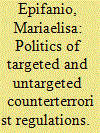

|
|
|
|
|
| Summary/Abstract |
Civil liberties came under pressure after Al Qaeda’s attacks in the U.S. and Europe. Governments in many Organisation for Economic Co-operation and Development countries started questioning the effectiveness of counterterrorist policies and regulations. Incumbents responded to terrorism not only by introducing ex novo (or re-adapting) laws and regulations affecting a large set of civil rights; they also responded to international terrorism by choosing between an untargeted and a targeted legislative response. Some governments reduced the liberties of foreign foes more than the freedoms of citizens, while others preferred burdening all individuals within their borders, immigrants and citizens alike. This article analyzes the determinants of targeted and untargeted antiterrorist responses to Al Qaeda terrorism in a sample of 20 Western democracies from 2000 to 2008. The findings suggest that patterns of targeted legislation were more pronounced in countries governed by right-wing incumbents and those where the decisional power in the cabinet is divided among a few number of political parties. In addition, a larger share of Muslims and the degree of ethnic fractionalization played a relevant role in determining governments’ choices of prime targets.
|
|
|
|
|
|
|
|
|
|
|
|
|
|
|
|
| 7 |
ID:
148926
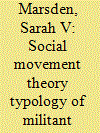

|
|
|
|
|
| Summary/Abstract |
Typologies are ubiquitous in terrorism studies, illustrating their continued appeal as a tool to further our understanding of this form of political violence. Despite this, to date, the promise of an empirically derived typology has largely been neglected. In addressing this gap, this article sets out a typology developed from Social Movement Theory. Using a novel statistical technique to derive a three-dimensional framework for categorising militant groups, the typology incorporates both organisational characteristics and the wider political context. The result is a typology defined by three conceptual constructs: political capacity, war-making capacity, and network capacity. Alongside these organisational features, imposing measures of the wider political opportunity structure reveals eight types of militant organisation. To explore the utility of the framework, a preliminary analysis interprets the typology in light of the presence of wider conflict. That a robust relationship is found between the various types and whether groups were operating in peacetime, civil war, or low-intensity conflict, goes some way to demonstrating its utility as an analytical tool. Conclusions draw attention to the importance of contextualising militant groups in their socio-political setting, and the benefits of combining theory alongside empirical analysis to develop robust characterisations of violent organisations.
|
|
|
|
|
|
|
|
|
|
|
|
|
|
|
|
| 8 |
ID:
148921
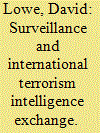

|
|
|
|
|
| Summary/Abstract |
Using the revelations Edward Snowden passed over to the press regarding the actions of the U.S.’s National Security Agency and the UK’s Government Communications Headquarters and their use of the Prism project, this article examines the law surrounding intelligence gathering in the U.S. and UK. Underpinning the analysis is the legal principle of proportionality as applied to balancing the interests of national security and individual liberties. After examining intelligence exchange procedures, which for the UK is through negotiated agreements between national security agencies and through the European Union’s policing agency, Europol, the main part of the article discusses legal challenges that have been made regarding surveillance and the use of anti-terror laws on citizens and the rationale behind the judicial decisions made in both the U.S. and UK jurisdictions. The argument forwarded is that there is a requirement for wide preventative powers being granted to counter-terrorism agencies and that the interests of national security and individual liberty are inclusive and, as shown by the cases covered in this article, we should rely on the judiciary to perform their function in applying proportionality to each case on its own merits.
|
|
|
|
|
|
|
|
|
|
|
|
|
|
|
|
| 9 |
ID:
148927


|
|
|
|
|
| Summary/Abstract |
This article evaluates the effects of terrorism on interventions into civil wars. Considering civil wars from 1970–1999, this study analyzes how the use of terrorism as a tactic affects external interventions on behalf of opposition groups, interventions on behalf of governments, and diplomatic interventions. While some authors would suggest that groups might utilize terrorism as a tactic to gain external support, this study finds little evidence that groups are actually successful in gaining such support. In fact, terrorism that targets civilians appears to actually decrease the likelihood of military interventions on behalf of opposition groups. Furthermore, in civil wars with high numbers of terrorist attacks there is a greater likelihood of economic intervention on behalf of governments, further weakening the potential benefit for groups in utilizing terrorism as a tactic. While this is certainly a welcome finding, a consideration of five case studies of suicide terrorism (Lebanon, Sri Lanka, Iraq, India, and Turkey) provides evidence that the use of suicide terrorism within civil wars may have decreased the likelihood of external interventions on behalf of the government and of diplomatic interventions. These results are more troubling and suggest potentially grave consequences for mediating many of these conflicts.
|
|
|
|
|
|
|
|
|
|
|
|
|
|
|
|
| 10 |
ID:
148923


|
|
|
|
|
| Summary/Abstract |
Many scholars working within the tradition of critical studies are sceptical of the presence of visible security measures in urban spaces, arguing that they cause fear and facilitate the political control of citizens. A study carried out in Denmark in 2011 sought to capture, describe, and rank factors impacting positively or negatively on the feelings of safety of Danish citizens, when being in a crowded place. Surprisingly, the response to security measures like fences, cameras, and uniformed guards was positive. More visible security apparently reinforced feelings of safety. This article discusses the findings and points to, amongst others, a high level of societal trust as one possible explanation.
|
|
|
|
|
|
|
|
|
|
|
|
|
|
|
|
|
|
|
|
|